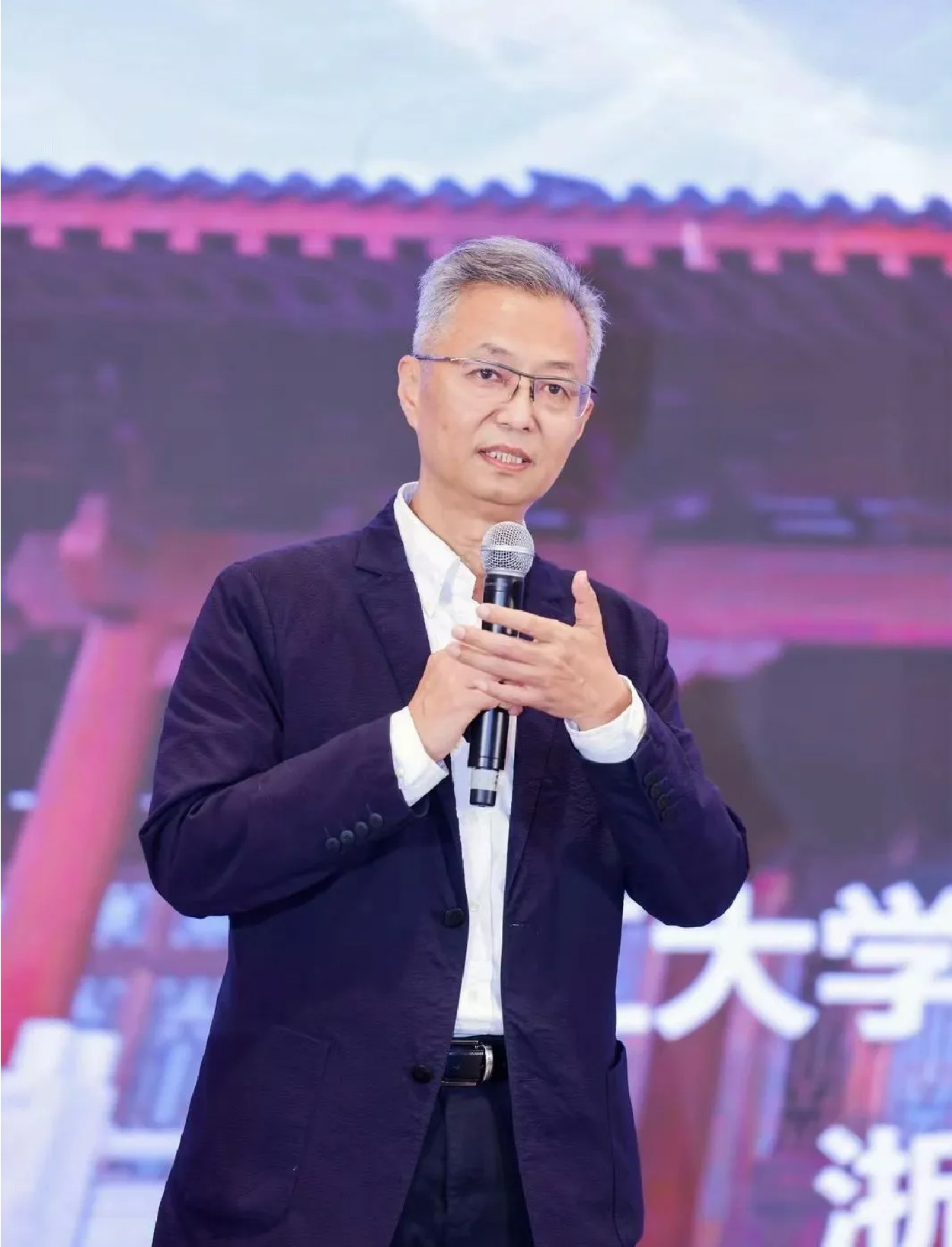China’s economy has transitioned from high-speed growth to high-quality development. To adapt to this new stage, it is crucial to accelerate the emergence of fresh drivers - “new productive forces” - while continually nurturing new momentum and competitive advantages. Only by transforming scientific achievements into genuine industrial applications can they become productive power. However, it is often said that for scientists, leaving academia to commercialize technology can be challenging - harder still to become a successful entrepreneur. Is it really so difficult for research-based entrepreneurial teams to “cross the chasm” and bridge the gap between technology and industry?

Bridging the Chasm: 30 Years of SUPCON (跨越鸿沟:中控30年)
A major new addition to the “C Theory (C理论)” series, Bridging the Chasm: 30 Years of SUPCON (跨越鸿沟:中控30年), has been released in November. It is co-authored by Professor WU Xiaobo (吴晓波), Zhejiang Province Distinguished Expert, Director of the Social Sciences Division at Zhejiang University, and Professor in the Department of Innovation, Entrepreneurship, and Strategy at Zhejiang University’s School of Management, and Dr. ZHANG Jiangrun (张江润), a researcher at Ruihua Innovation Management Research Institute. This book systematically explores how SUPCON - often referred to as “Zhongkong” - overcame multiple industry cycles through self-driven innovation, and it distills the practical experience of its founder, Professor CHU Jian (褚健), in bridging science and industry.

Professor WU Xiaobo (吴晓波) | You can learn more about Professor’s academic background here
|
Unique Growth Path of a National Industry Leader |
Thirty years ago, China’s automation control systems market was almost entirely dominated by foreign brands such as Honeywell, Yokogawa, Emerson, and Siemens. As a result, core industrial safety was effectively held in foreign hands, and China’s critical industrial infrastructure faced significant security risks. In response, Professor CHU Jian, an automation specialist from Zhejiang University’s Department of Chemical Engineering, decided to leave academia to transform his research into productive power and “serve the nation through industry.”
Since its establishment, SUPCON has navigated fierce competition from international giants and the uncertainties of changing eras. Today, it is described as “a high-tech enterprise capable of matching Western firms with independent intellectual property in industrial control systems and information security.” How did SUPCON carve out a unique growth path in 30 years of innovation? How did Professor CHU Jian, as a founder with a strong scientific background, lead his company from “secondary innovation” to developing some of China’s most advanced technology?

Bridging the Chasm: 30 Years of SUPCON (跨越鸿沟:中控30年) charts SUPCON’s nonlinear trajectory, showing how its founding team, driven by the mission to “reinvigorate domestic automation,” persevered for three decades to become a frontrunner in China’s process industrial control field. Their experience offers valuable insights to industrial enterprises seeking new business models and to latecomer firms aspiring to break through and achieve high-quality development.
|
A Homegrown Management Perspective: “C Theory” (C理论) and Lessons for Commercializing Research |
Over many years, Professor WU Xiaobo has worked to build an indigenous innovation management framework “C Theory (C理论)”, aimed at answering why some companies continue to grow rapidly while others stall and vanish. Originating nearly 40 years ago, “C Theory” focuses on managing technological innovation during paradigm shifts, stressing how to embrace uncertainty and emerge as a leader when new technology cycles take shape. It has studied top Chinese enterprises such as Huawei, Geely, Hangyang, Hikvision, and Transfar.

|
"C Theory" Series |
SUPCON stands out as a company founded by a well-established university professor. Professor WU and his research team conducted in-depth interviews with over 150 SUPCON employees—including multiple discussions with CHU Jian, JIN Jianxiang (金建祥), and other key players—and reviewed archival materials spanning the company’s history. They applied the lens of “C Theory” to uncover broader patterns of how SUPCON achieved “secondary innovation,” competed alongside major players, and made the leap to “catch up and surpass,” eventually aspiring to become a world-class enterprise.
Divided into four sections, “Original Aspiration: Stepping Out of the Ivory Tower,” “Determination: Breaking Through,” “Ambition: Rebirth from the Ashes,” and “Confidence: Shaping a New Landscape”, each chapter ends with a concise summary connecting the narrative to “C Theory.” By analyzing how SUPCON seized opportunities emerging from shifting technology paradigms, this book offers practical takeaways for transforming scientific achievements into industrial products and provides direction for research-based entrepreneurial teams.

|
Through thorough and systematic case studies, WU Xiaobo’s team uncovered the scientific principles and rational explanations behind the remarkable rise of Chinese companies. They empirically validated the core CAS framework of "C Theory" (C理论) , which consists of three main components: context, agency-based co-enactment, and strategy. You can read more about it here |
|
Dispelling the Myth: Can Scientists Become Great Entrepreneurs? |
Many assume that scientists are ill-prepared for business. How can someone trained for deep specialization expand into the broader leadership demands of entrepreneurship? In Bridging the Chasm: 30 Years of SUPCON (跨越鸿沟:中控30年), the authors thoroughly examine each developmental stage of SUPCON—covering technology innovation, product iteration, talent incentives, and quality management—and spotlight the enterprise spirit of its founder, CHU Jian.

|
CHU Jian, founder of SUPCON |
A top figure in China’s automation sector, CHU Jian has led multiple major national research initiatives and garnered many prestigious technology awards. As an entrepreneur, he has steered SUPCON to break foreign monopolies, paving the way for China’s independent industrial control systems and national security. His story vividly illustrates the hurdles and triumphs that a scientist-turned-entrepreneur may encounter in bridging technology and industry.
|
“ |
The chasm between scientific research and industrial application once seemed insurmountable, yet SUPCON’s 30-year development has shown a living example of crossing that divide,” highlights Professor WU Xiaobo. |
Indeed, numerous tech startups are now emerging as prime engines of innovation. Their founders are not only spearheading research projects but also driving successful market entry in new and future-facing industries. This book thus serves as a valuable model for both scientific entrepreneurs and established technology leaders striving to position their enterprises at the higher end of global value chains.
|
Expert Endorsements |
|
“ |
|
|

ZHU Sendi (朱森第): Honorary Director of the Expert Committee at the China Machinery Industry Federation, Honorary Director of the National Intelligent Manufacturing Expert Committee This book is a powerful witness to how Chinese industry has grown from large-scale to world-class. SUPCON’s 30 years align with a pivotal era of Chinese industrial development. Its journey exemplifies how a domestic manufacturer can achieve independent innovation and break through foreign blockades. Bridging the Chasm: 30 Years of SUPCON (跨越鸿沟:中控30年) is not only a history of SUPCON but also a testament to China’s transformation from big to strong in manufacturing.” |
|
“ |
|
|

WANG Tianran (王天然) Academician of the Chinese Academy of Engineering, Robotics and Industrial Automation Expert In the face of complex international environments, China’s industrial automation must keep core technologies firmly in its own hands. I have seen SUPCON’s growth for more than two decades—from its earliest technology breakthroughs to the joint evaluation of the i-MOC system in 2021. This book offers a complete story of SUPCON’s evolution and is essential reading for anyone seeking to understand the development of China’s automation technology and independent innovation.” |
|
“ |
|
|

YANG Shanlin (杨善林): Academician of the Chinese Academy of Engineering, Management Science and Information Systems Engineering Expert I have always believed in applying research where the nation needs it most. CHU Jian and the SUPCON team stepped out of academia and built a bridge between research and industry, forging a new path for commercializing scientific output. Bridging the Chasm: 30 Years of SUPCON (跨越鸿沟:中控30年), grounded in the original ‘C Theory,’ reveals how SUPCON continually reinvented itself through innovation and provides a fresh perspective on 30 years of striving for ‘catch up and surpass.’” |
- "Crossing the Chasm: 30 Years of SUPCON" is a new addition to the "C Theory" series of books by WU Xiaobo’s team. In recent years, the Innovation Management team at Zhejiang University School of Management has focused on the innovation management practices of Chinese enterprises. Researchers have developed a system of original innovation management theories tailored for China, aiming to provide local enterprises with effective theories and methods for innovation management.
- You can read the original article in Chinese here